Public transit agencies prepare for the post-pandemic era.
By Stephanie Jordan
Managing Editor
Transit California
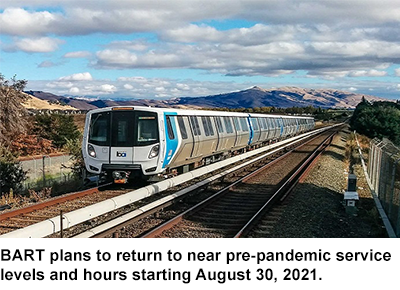
When California fully reopened its economy on Tuesday, June 15 with no physical distancing restrictions for most businesses and activities in California, health officials also approved the full return of full capacity on all buses and trains. In the Bay Area, BART ridership on that Tuesday was 78,377, representing 19 percent of pre-COVID-19 budget projections for a weekday in June. As of June 16, it was the highest ridership day since the start of the pandemic. Overall, daily Bay Area toll bridge traffic has roughly doubled from the COVID-era lows registered in early April 2020 and now averages 85 percent of the levels recorded in mid-June of 2019.
Though masks are still required (through September 13, regardless of rider vaccination status, per federal law) and amid COVID-19 spike concerns, public transit agencies throughout the state are moving from reacting to the crisis to recovery and institutionalizing what has been done well. From frequent cleaning and nightly anti-viral fogging to upgraded advanced HVAC system air filters across entire fleets, the addition of onboard hand sanitizers, touch-free mobile ticketing, operator distancing barriers, offering micro transit replacement options, distributing personal protection equipment, and more, public transit agencies have taken steps throughout the pandemic to combat the spread of COVID-19 and follow safety restrictions. But of these mitigation steps, which ones will remain a practice in the post-pandemic era? .png)
One possible practice that might return is fare-free transit. Waiving fares for transit service became common during the height of the pandemic, as agencies enacted social distancing efforts to keep operators farther away from riders. With fareboxes placed in close proximity to drivers, rear-door boarding and fare-free rides became common practice.
“Many transit agencies across the country operated without fares during some or all of the pandemic, either formally removing fares or suspending fare inspection and enforcement (i.e., an honor system),” observes Jacob Wasserman, Research Project Manager, UCLA Institute of Transportation Studies. “Looking forward, I think that some transit agencies will at least consider going fare-free permanently, weighing the costs (like tradeoffs with service supply) and benefits of doing so, with the pandemic as partial evidence. Agencies that collect a smaller share of their total revenue from fares may find it easier to go fare-free. LA Metro, for instance, to whose budget fares contribute a relatively small share, is on the verge of implementing fareless pilot programs for students and low-income riders and is studying fare-free transit for all riders.”
Taking extra steps to keep riders and employees healthy was extremely important throughout the pandemic. Everything from homemade barriers to high-end shields was created to separate drivers from passengers and cleaning protocols were heightened.
“The pandemic forced us to rethink how we can better manage the safety of our employees and customers, and some of the things that we instituted on our buses that I can see us keeping are the permanent, Plexiglas barrier in the bus operator compartment and the 25 percent fresh air intake feature on our HVAC systems,” says Mona Babauta, Deputy General Manager-Bus Division of Golden Gate Bridge, Highway, and Transportation District. “We were glad that we already had the latter, but the pandemic highlighted the importance of not deviating away from that in future bus purchases. With respect to our cleaning process, we plan to keep fogging our buses with a hospital-grade disinfectant as part of our regular cleaning regimen moving forward.”
As visitors and employees return to the Disneyland Resort, Knotts Berry Farm, Angel Stadium, and other destinations throughout Orange County, Anaheim Transportation Network (ATN) plans to keep much of the safety protocols implemented during the pandemic.
“Cleaning and hygiene protocols are here to stay,” asserts Diana Kotler, Executive Director of ATN. “The message that transit is Clean and Safe will become our motto. Digital ticketing is now fully accepted and will replace all previous fare media. In our case, we went 100 percent digital and received great reviews from customers.”
Monterey-Salinas Transit (MST) also plans to continue to utilize a hospital grade germicide to clean and sanitize all surfaces within the passenger cabins each night, fleet wide. The use of a pressurized ammonia-based solution to power wash and disinfect passenger waiting areas at major transfer locations will continue as well, to help keep employees, customers, and the public at large safe.
“MST will keep the physical Do Not Cross delineation line,” adds Carl Sedoryk, MST’s General Manager and CEO. “The newly added strip is affixed to the coach floor parallel to the tire well and provides a protective six-foot distance between bus operator and riders while the bus is in motion. Our operators really like that. And the hand sanitizer dispensers will remain too.”
Another practice that MST will explore maintaining is the option to work from home.
“We found that we really can work from home,” explains Sedoryk. “So we’re going to try it for 90 days. We will spend the majority of time at the office, but then employees can also work from home too. Regardless, there will need to be transition time from stay-at-home to returning to work with eldercare, daycare, and such that will require adjustments. By working from home we can limit green-house gas emissions and congestion. We plan to continue this practice to see if we can still be successful, while having employees drive less.”
MST is not alone in this discovery. One of the aspects of the pandemic that surprised Alva Carrasco/AVP-Transit and Rail, WSP USA and President of the Board of Latinos In Transit was the speed with which people transitioned to working remotely. In fact, U.S. productivity in the third quarter of 2020 rose 4.6 percent, following a 10.6 percent increase in the second quarter, which is the largest six-month productivity improvement since 1965. (Per: “Productivity and costs: Third quarter 2020, revised,” U.S. Bureau of Labor Statistics, December 8, 2020 bls.gov.)
“All the COVID practices that came out of this crisis taught us as an industry that we weren’t as resilient as we thought we were,” observes Carrasco. “The pandemic demonstrated to the entire world how vital public transit is to our social and economic wellbeing. Although we got kicked in the teeth, transit agencies did a phenomenal job to pivot resources and to think of innovative ways to safeguard our riders and employees. I believe everything we learned in the past year will stay with us indefinitely.”
Contactless Fare Payment 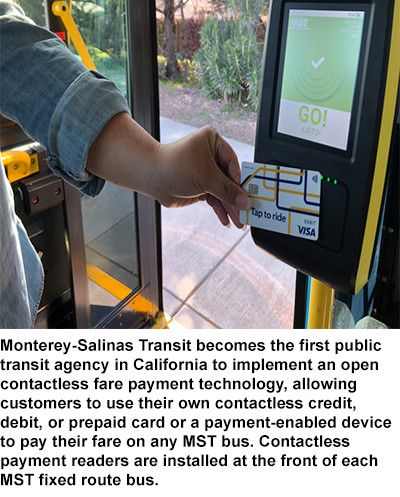
Kotler feels that real game-changers coming out of the pandemic will be in digital payments, communication, and information technologies.
“There is no return to pre-COVID way of doing things,” she believes. “Consumers will demand this type of innovation and the innovation in the transit industry will be driven by the ‘cashless/ touchless’ expectations riders have experienced in other industries.”
To Kotler’s point, in May, MST became the first public transit agency in California to implement an open contactless fare payment technology, that allows customers to use their own contactless credit, debit, or prepaid card or a payment-enabled device to pay their fare on any MST bus—just like they tap to pay for a coffee, groceries, or a meal. MST’s six-month contactless payments demonstration is the first of many facilitated by the California Integrated Travel Project (Cal-ITP), a Caltrans initiative to enable easy and accessible travel planning and payments.
“A lot of work went into setting up the transactions to go live, but it is all seamless to customers,” explains Sedoryk. “We are seeing consistent and growing usage. Customers are able to use just their debit or credit card. There are no downloads of an app or the purchase of a separate product needed, which is commonly required in other types of fare implementations.”
Sedoryk goes on to say that the technology is standard off the shelf and is widely available to all retail sectors, not just public transit. “Since this is not custom designed solely for public transit, the cost per unit is very low. Plus, through state led efforts, procurement might become part of a multi-state contract, which will drive the price point down even further for the hardware, software, service, and transaction fees. In addition, our coach operators are happy with the speed of the quick passenger boarding – since it’s just swipe and go it limits dwell time. Operators also like the health benefit, since customers do not have to linger at the farebox.”
Customers are seeing the benefits of the contactless payment readers. Riders can swipe upon boarding and again on exit and be charged only for the distance traveled, which might be less than the normal cash fee. The platform also offers “fare capping,” which ensures that riders will not be charged more than $10.00 per day, no matter how many times they ride in a day—as long as they pay with the same contactless card or mobile wallet throughout the day.
“This is a really cool feature because it mimics daily, weekly, and monthly passes,” says Sedoryk “With fare capping, once a rider reaches a transaction per day, or week or month, there is no longer a charge to ride. You can hit the daily limit, then the weekly level, and keep building up to a monthly level. It’s like a mobility deductible: once you reach the deductible the rest of the rides are covered. This is especially good for low-income riders because they don’t have to come up with a large monthly payment up front, like when purchasing a pass. Instead it is pay-as-you-go so riders can budget for transit costs.”
With equity especially in mind, Sedoryk notes that in the coming months MST will be able to also accept Square payment solutions. This means that if customers do not have credit or debit cards, they can sign up for Square with just an ID and are not required to have a relationship with a bank or financial institution.
“This is especially important for our hospitality and agricultural workers,” Sedoryk adds.
Another feature Sedoryk is looking forward to implementing is discount fares for those eligible. Using an interface through the Department of Motor Vehicles, DMV records can be accessed checking for eligibility. “What I like about that, is it takes us out of the ID business,” Sedoryk states. 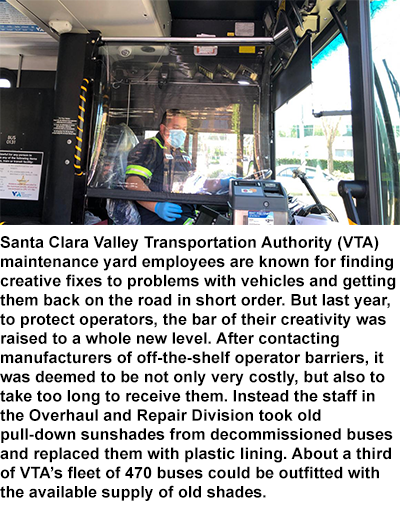
While adding the contactless payment option, MST continues to accept all its current forms of payment at the bus farebox for regular and discount fares: cash, GoCards, and monthly/weekly/daily GoPasses.
Essential Workers & Equity
The unprecedented times that the novel coronavirus pandemic put into motion beginning in early March 2020 stripped public transit of riders. What came into clear focus was the critical mobility needs of the transit dependent, healthcare workers, first responders, social service providers, childcare workers, grocery store employees, and other essential workers that were exempt from Governor Gavin Newsom’s call to shelter-in-place. Though ridership decreased dramatically in observance of the Governor’s directive, California public transit agencies continued to serve customers daily.
“Our commuter ridership took a huge hit when the first Shelter-in-Place order was implemented in March 2020, and we immediately saw our core ridership shift from routes serving higher income neighborhoods in Marin County to our routes that primarily served essential workers, lower income riders, and people of color along the Highway 101 corridor,” explains Babauta. “Over a year later, our ridership is still down roughly 75 percent of where it was before COVID-19. The pandemic and other impactful events in 2020 highlighted the fact that we need to do more around incorporating equity into how we deliver service and make decisions.”
Continues Babauta, “At my agency we are traditionally a commuter bus system, and our core ridership prior to COVID was mostly composed of customers who were primarily Caucasian, well-off, and privileged in many respects. Our traditional commuters, however, are not the ones currently using our system. Instead, we have essential workers, including people of color and low-income riders, who are normally not our focus in the decision-making process. These essential workers kept our economy going and continue to do so. As we rebuild our systems, as an industry, we need to prioritize equity in service decisions for remaining relevant and becoming increasingly effective at providing service that contributes to stronger, more resilient, and inclusive communities.”
In looking back, Carrasco notes that there was a moment in early 2021 where data really began to reveal massive equity issues with disadvantaged populations not having convenient access to COVID-19 testing and vaccines. “This transition to a focus on equity is probably one of the most important discoveries from the pandemic,” believes Carrasco.
The U.S. Department of Transportation’s Federal Transit Administration (FTA) recently highlighted how transit agencies across the country are helping people in their communities get access to COVID-19 vaccines. In California, many public transit agencies did or continue to offer free transportation to vaccination sites or are even using their transit stations and facilities as vaccination sites. As an example, Metro is making it as easy and convenient as possible for its riders to get a COVID-19 vaccination during their travels by establishing four vaccination sites at Metro stations — El Monte Station, Harbor Gateway, Crenshaw/105 and Del Amo. There are also plans for a site at Union Station to open soon.
Babauta sums up the position of many California transit agencies, when she says: “For the foreseeable future, equity will continue to be our ‘guiding star’ as we rebuild our system and carefully expand our service over the next couple of years.”
The Bounce-Back 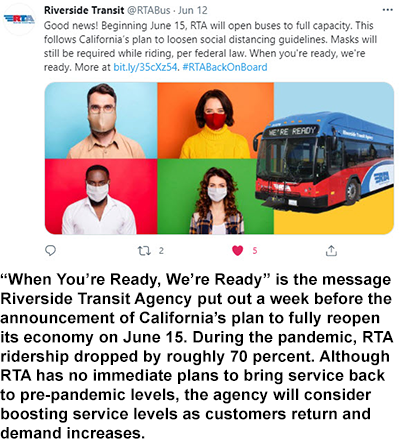
Though variants of coronavirus continue to spread, California’s vaccination rate is high and the COVID infection rate continues to decrease. At this point in time, public transit agencies are beginning to take cautious steps forward toward recovery for the first time since Governor Newsom declared a state of emergency on March 4, 2020. Although, what will recovery be like?
Keith Martin, Executive Director, Yuba-Sutter Transit believes it will not be easy for his agency. “We are expecting a prolonged recovery and some services may never return to pre-pandemic levels. With that expectation, service, staffing, equipment and policy decisions will be especially problematic for the foreseeable future.”
Carrasco agrees with Martin. “I expect that it will be difficult and long. There is a finite amount of federal money that can be pumped into transit agencies. And the final duration of this pandemic is still unknown. Either way, agencies have suffered tremendous financial and workforce losses that will take time to recover.”
For many agencies it will be a wait and see approach to recovery plans.
“The bounce-back for Golden Gate Transit will take some time, we think,” shares Babauta. “We are traditionally a commuter bus system, and our core ridership was primarily composed of white collar professionals working in the financial and tech industries in downtown San Francisco. However, given the increase in remote and hybrid work schedules, we will need to see how employees return to work before we make any permanent decisions on our long-term service design.”
Recruitment of operators and staff was a challenge pre-pandemic, but with the pandemic came an even greater strain on resources. Currently, labor shortages are not only an issue for the public transit sector. The U.S. Chamber of Commerce shows there were a record 8.1 million job openings in the United States in March 2021 and about half as many available workers for every open job across the country as there have been over the past 20 years.
“The growth in traffic across the Golden Gate Bridge and our ability to recruit new bus operators will also dictate much of our growth in the coming months,” acknowledges Babauta. “With 15 percent of our bus operator workforce retiring in the past year, we do not have sufficient staff to operate pre-COVID service levels reliably at this point. Additionally, 50 percent of our operating budget is financed with bridge tolls. So, we definitely need to see positive changes in both of these areas before making any final decisions on service levels.”
Kotler agrees that the labor shortage is impacting recovery plans. “It is going to be complicated because of the lack of personnel resources, but easier (emotionally and financially) than dealing with the pandemic itself. A sense of optimism is very, very important! What I am seeing are people that really want to return to their ‘pre-COVID’ lives. The marketplace is bursting with people seeking normalcy. The same is true for front-line personnel – hospitality, theme park, and even our operators. Most employees were eager to return to work and not as concerned about safety protocols, because they just want things to be back to normal.”
With the pandemic starting to be somewhat in the rear-view mirror, Kotler characterizes the last 15 or so months as being full of “Humbling experiences which brought back humility, and at the same time, a drive to survive.”
Asked for his biggest take away, Martin has an even deeper appreciation for the Yuba-Sutter Transit family. “Our soft-assets, our people, especially our front-line personnel have always been the most important component of our operation and this crisis has only reinforced that knowledge, so this experience has made us more resilient than ever.” 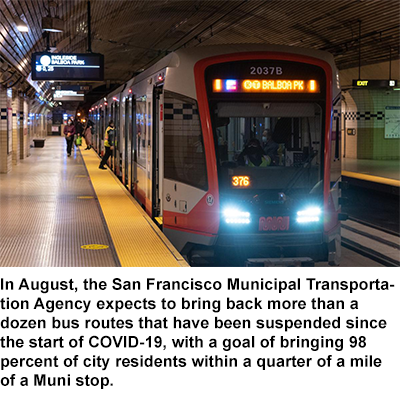
Asked if she thought Golden Gate Transit was more resilient than before, Babauta says, “Yes. I think we are more resilient now as an organization, but the dramatic changes in our ridership have resulted in our continued need to rethink our business model around service delivery and our priorities around that. Equity is our top priority right now given that almost all of our current customers depend on us to meet daily life needs. However, as the skyscrapers and economy slowly reopen in downtown San Francisco, we will need to consider how our system can expand to meet other organizational priorities, such as growing ridership, reducing traffic congestion, and fighting climate change.”
Keep California Moving
The unprecedented times that came with the pandemic is giving way to an opportunity to re-examine how public transit in California (and beyond) will provide services into the future.
“We thought we were well prepared for emergencies,” states Sedoryk. “We have conducted many workflow scenarios for wildfires, floods, and the like. But those all had a beginning, a middle, and an end. We were not prepared for this length of time. But what has come to light is we can clearly see who our core customers are. No one wanted to ride the bus during COVID-19 and yet, we had riders. This experience requires us to think about complete service redesign and positive social equity outcomes. It has forced us to re-think the role we play in the community and our responsibility to provide access to opportunity. What we have learned is people really depend on us.” 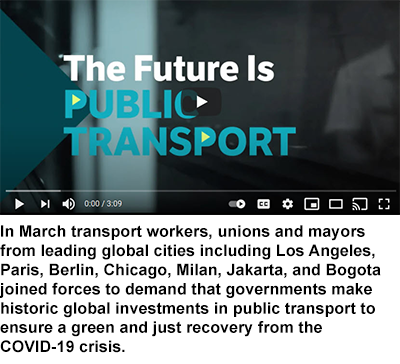
Transport workers, unions, and mayors from leading global cities including Los Angeles, Paris, Berlin, Chicago, Milan, Jakarta, Bogota have joined forces to demand that governments make historic global investments in public transport to ensure a green and just recovery from the COVID-19 crisis. Spearheaded by C40 Cities, a coalition of mayors representing 97 of the world’s largest cities, and the International Transport Workers' Federation (ITF), who represent 20 million transport workers, “The Future is Public Transport” initiative is calling for an urgent injection of stimulus funding in public transport services and infrastructure in order to drive economic stimulus, job creation, and climate action.
C40 Cities’ newly released research confirms that green investment in global public transport systems will not only safeguard existing jobs, but will also create millions of decent, sustainable jobs, and drastically cut emissions in the next decade.
"A significant lesson that I hope transit agencies and decision-makers take away from the pandemic is that transit is an essential service,” concludes Wasserman. “Many essential workers relied on transit during COVID, just as they did before the pandemic too. Low-income travelers, riders of color, and those with limited or no access to private cars disproportionately use public transit. Transit's social service role is therefore paramount (especially since its other key role, moving a lot of people together to dense, central destinations, was disrupted and is still recovering). Operators and policymakers often tout a number of different, potentially conflicting purposes for transit, but if anything, COVID-19 further proves that equity must be central to transit planning."